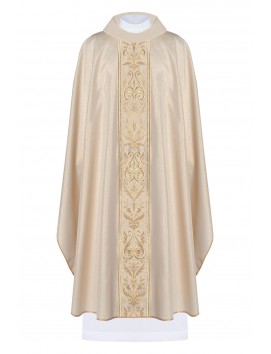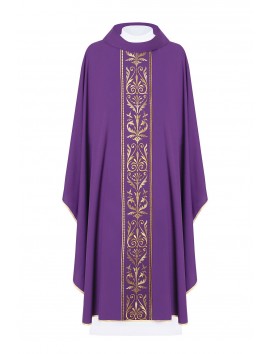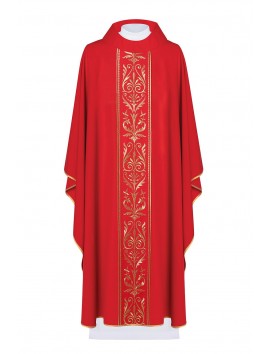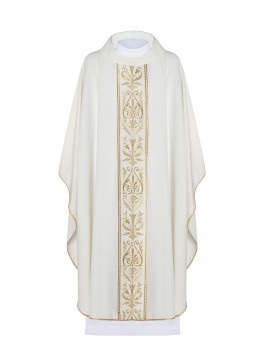In general, a cassock is a specific type of religious garment worn by certain clergy in various Christian denominations. The rules and guidelines for who can wear a cassock vary depending on the denomination and the specific role of the clergy member.
For example, in the Roman Catholic Church, bishops, priests, and deacons are permitted to wear a cassock, while seminarians are not permitted to wear a cassock until they have completed a certain stage of their education. In the Anglican Communion, wearing a cassock is generally reserved for ordained clergy, and the rules may vary depending on the particular province or diocese.
In summary, whether a priest can wear a cassock depends on the specific rules and policies of his denomination and the requirements of his role within the clergy.

Can a priest wear a Pellegrina?
A pellegrina is a type of sleeveless cape worn by some Catholic clergy over a cassock during liturgical celebrations. The use of the pellegrina is not universal in the Catholic Church, and is most commonly used in some European countries.
Whether a priest can wear a pellegrina depends on the rules and policies of his particular diocese or religious congregation. In some cases, the use of the Pellegrina may be permitted, while in others it may not be used at all.
It's worth noting that the use of liturgical vestments such as the pellegrina is generally intended to symbolize the sacredness of the liturgical celebration and to distinguish the clergy from the laity. Ultimately, whether a priest wears a pellegrina is a matter of local custom and tradition, subject to the guidelines and regulations of the Church or religious community to which the priest belongs.
Can non clergy wear cassock?
Traditionally, the cassock is a type of religious dress worn by clergy in various Christian denominations. In some cases, however, non-clergy members may wear a cassock for specific purposes, such as acolytes or altar servers during liturgical services.
Outside religious contexts, it is unusual and not typical for non-clergy to wear a cassock, as it is a specific type of garment often associated with religious authority and formal occasions. Generally, the cassock is reserved for clergy who have been ordained or are in the process of being ordained, and its use by non-clergy may be considered inappropriate or disrespectful in certain contexts.
In summary, while non-clergy may be permitted to wear a cassock in certain religious contexts, it is not common practice and is subject to the rules and policies of the specific religious community. Outside religious contexts, it is unusual and may be considered inappropriate or disrespectful for non-clergy to wear a cassock.
What is worn under a cassock?
What is worn under a cassock can vary depending on the preferences of the individual and the traditions of their religious community. In general, however, it is common for clergy to wear a clerical shirt, a type of dress shirt with a stiff white collar designed to be worn with a cassock. The collar is usually made of plastic or linen and is detachable from the shirt so that it can be easily replaced when worn or soiled.
In addition to the clerical shirt, a belt or cincture may be worn around the waist to hold the cassock in place and give it a more fitted appearance. Some clergy also wear a fascia, a type of sash worn over the cassock, as a sign of authority or distinction within the church.
It's worth noting that in some religious communities, the cassock itself may be worn as an outer garment over other vestments, such as an alb or surplice.
When did priests stop wearing cassocks?
Priests have not stopped wearing cassocks. The cassock is still worn by many clergy in various Christian denominations, especially during formal religious ceremonies. However, it is worth noting that some religious communities have modernized their dress codes and may allow their clergy to wear more casual clothing for certain occasions. In addition, some individual priests may choose to wear other types of clerical dress, such as a clerical shirt and pants, rather than a cassock. However, the cassock remains an important symbol of religious authority and tradition in many Christian communities, and it is still widely worn by clergy today.
Who can wear the fascia Catholic?
In the Catholic Church, the fascia is a type of sash worn over the cassock by certain members of the clergy as a sign of authority or distinction. The fascia is typically worn by bishops, cardinals, and certain other high-ranking officials in the Church, such as abbots and protonotaries apostolic.
In addition to its use as a sign of authority, the fascia may also be worn by certain priests during certain liturgical celebrations, such as a funeral Mass or a wedding, as a sign of their role in the ceremony. However, this practice may vary according to the traditions of each parish or diocese.
It's worth noting that the use of the fascia is not limited to the Catholic Church. It is also worn by some Anglican and Orthodox clergy as a sign of their rank or position within their respective religious communities.
Who would wear a soutane?
The soutane, also known as a cassock, is a long, close-fitting robe worn by certain members of the Catholic clergy as a sign of their religious vocation. Traditionally, the soutane was worn by all members of the clergy, from bishops to deacons. In modern times, however, its use has become more limited.
Today, the soutane is worn primarily by priests, seminarians, and some religious brothers. In some religious orders, such as the Society of Jesus (Jesuits), the soutane is worn only on special occasions, such as formal religious ceremonies or when performing official duties.
It's worth noting that the use of the soutane varies according to the traditions of each parish or diocese. Some priests may choose to wear a more modern version of the soutane, such as a clerical shirt and pants, while others may prefer to wear the traditional soutane.
Why do priests wear a cassock?
The cassock, also known as a soutane, is a long, close-fitting robe worn by certain members of the Catholic clergy, including priests. The cassock has a number of symbolic and practical meanings within the Church.
One of the main reasons why priests wear the cassock is to signify their religious vocation and to distinguish them from the laity. The cassock is a visible sign of the priest's commitment to the Church and his adherence to the teachings of the faith. It also serves as a reminder to the priest himself of his devotion to God and his duty to serve the people of his parish.
The cassock is also a practical garment for the priest, as it is comfortable to wear and allows for easy movement during liturgical celebrations. The long sleeves and flowing fabric help keep the priest cool in hot weather, and the dark color of the cassock is both practical and symbolic, representing humility and detachment from worldly concerns.
What is a priest’s cassock?
A priest's cassock, also known as a soutane, is a long, tight-fitting robe worn by Catholic priests as a sign of their religious vocation. The cassock typically reaches to the ankles and has long sleeves that cover the arms. It is traditionally made of black wool, although other colors may be worn depending on the occasion. The cassock is usually fastened at the neck with a series of buttons and may also have a waistband or sash to cinch the garment at the waist. The cassock is a practical garment for priests, allowing for ease of movement during liturgical celebrations and providing a degree of modesty and protection from the elements. It is also a visible sign of the priest's commitment to the Church and his adherence to the teachings of the faith.




















